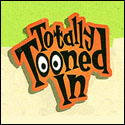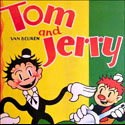 When I was growing up in New York City, between the morning sitcom reruns and the afternoon cartoon shows (I didn’t get out much), was The Joe Franklin Show (aka Joe Franklin’s Memory Lane). Joe Franklin was quite addictive – a daily show mixing current show business and nostalgia – he was a portal to the past for many baby boomers in those pre-internet days.
When I was growing up in New York City, between the morning sitcom reruns and the afternoon cartoon shows (I didn’t get out much), was The Joe Franklin Show (aka Joe Franklin’s Memory Lane). Joe Franklin was quite addictive – a daily show mixing current show business and nostalgia – he was a portal to the past for many baby boomers in those pre-internet days.
One thing I loved about Joe is that he’d occasionally run cartoons. Actually he seemed to only run two cartoons, over and over again. They were Fleischer Screen Songs. One of them was Romantic Melodies (with Arthur Tracy, The Street Singer), the other one was School Days with Gus Edwards.
Gus Edwards was, as Joe would tell us, a veteran vaudevillian and master song writer who rarely appeared on screen (click the sheet music at right to enlarge). Joe Franklin made me appreciate the live performances in the Screen Songs (which were rarely being shown by the mid-1960s) as much as the Fleischer cartooning – and that led to my appreciation of classic film. Thank you Joe… here’s a rare copy of School Days – unfortunately missing most of the live action sing-along footage (I’ll bet Joe still has a complete copy of this, somewhere):
Though its missing in the print above, Fleischer’s Screen Song was not “School Days” only bouncing ball appearance in a Paramount film.
“School Days”, the song, was written in 1907 by Gus Edwards and Will Cobb – and it became a standard. Edwards himself, in addition to being a performer, was known to have “discovered” Eddie Cantor, The Marx Bros. and Ray Bolger (among many others). In Paramount’s 1939 feature The Star Maker, Bing Crosby plays a character loosely based on Gus Edwards who, at one point in the film, leads the audience to follow the bouncing ball and sing School Days! I assume that Paramount considered the “bouncing ball” its property and since the Fleischer’s were no longer using it, included it here. Did the Fleischer Studio in Miami provide the bouncing ball and lyrics – perhaps lifted from the 1932 Screen Song?
Paramount began making new bouncing ball cartoons almost as soon as the Fleischer’s left their Miami studio. In 1948 Famous Studios produced one – Readin’ Ritin’ and Rhythmatic – which was a quasi re-do of the Fleischer’s School Days short. It’s also one of the rarer shorts from this period – anyone have a 16mm copy? (Don’t worry, the 35mm master materials exist in a well-known archive).
Courtesy of our friend Mark Newgarden, we have below a rare audio track from Readin’ Ritin’ and Rhythmatic. This is the scratch track of the original recording session – listen carefully at and you can hear the conductor lead the chorus (at the 1:31 and 2:10 marks). This is the actual recording the animators received (on an acetate disc) to animate to. Enjoy!
(Special thanks again to Mark Newgarden, William Carroll – and Mr. Peter Mintun for the sheet music cover)


 Jerry Beck is a writer, animation producer, college professor and author of more than 15 books on animation history. He is a former studio exec with Nickelodeon Movies and Disney, and has written for The Hollywood Reporter and Variety. He has curated cartoons for DVD and Blu-ray compilations and has lent his expertise to dozens of bonus documentaries and audio commentaries on such. Beck is currently on the faculty of CalArts in Valencia, UCLA in Westwood and Woodbury University in Burbank – teaching animation history. More about Jerry Beck [
Jerry Beck is a writer, animation producer, college professor and author of more than 15 books on animation history. He is a former studio exec with Nickelodeon Movies and Disney, and has written for The Hollywood Reporter and Variety. He has curated cartoons for DVD and Blu-ray compilations and has lent his expertise to dozens of bonus documentaries and audio commentaries on such. Beck is currently on the faculty of CalArts in Valencia, UCLA in Westwood and Woodbury University in Burbank – teaching animation history. More about Jerry Beck [








Another interesting rare piece of animation history! Thank goodness for people like you,Jerry and Mark,keeping at least part of the toon dream alive!
Never before there has been a higher demand on this stie for a DVD release of the “Screen Songs”. I mean, first Thunderbean Thursday, now Jerry is uncovering lost screen songs with “School Days”, what next? “Rare Flesicher Screen Song with Paramount Opening”? “Lost ‘Short’nin’ Bread’ Gag”? “Bouncing Ball knockoffs”?
i was (very) priveledged to get ON the show (remember that, Jerry?), and to promo the Toon Fest at the Thalia. Luv the toons!!
I had the privilege to meet Joe Franklin, not too long ago, at “The Actors Temple,” an old synagogue in Hell’s Kitchen once popular with show-biz legends like Sophie Tucker and the bros. Marx and Howard. There aren’t many show-biz legends left that attend services there, but Joe certainly fits the bill. Would love to see him broadcasting again, or even to hear him interviewed.
Ugh, I hate it when the video “adjusts” itself.
Yes… Jerry, did you accidentally check any “Stabilize” filter option when uploading the Fleischer School Days video to YouTube? (I’m not a YouTube member, but I think I read that there are filters that you can select to be run on the video as it is uploaded, including a “Stabilize” filter.) Such filters (a.k.a. “deshake” filters) are meant to be used on home videos where the operator was not holding the camera steady, and should practically never be used on film transfers, as they ruin the original pans, zooms, compositions, etc. in films.
I re-uploaded SCHOOL DAYS without the “Stabilize” feature. Happy now? 😉
Much better. Thanks!
Those filters help nobody Jerry, especially on videos that aren’t shot by hand!
Joe was at the opening of Vince Giordano & The Nighthawks on Monday night – he usually tells the same three jokes every time I see him, but there was a new one this time: “You’ve seen the pictures of missing kids on milk cartons? I heard that they’re now going to start putting pictures of missing transvestites on half & half!” Bada bing!
At some point I’ll send Jerry some later versions of “School Days” – Dizzy Gillespie & Louis Jordan, it was popular for a time in bebop & early R&B bands, believe it or not.
What a nice post, with the cartoon, the backgrounds, and the rare audio track.
The calligraphy of the words looks like early 1930s Fleischers — by 1939 the studio’s graphic design had trended more towards the art deco look in its lettering — but the movement of the bouncing ball doesn’t seem right for a Screen Song. Guess we’ll have to wait until the 35mm master materials that exist in a well-known archive becomes more available to find out for sure.
You can see Gus Edwards in a rare on-screen performance in MGM’s HOLLYWOOD REVUE OF 1929, for which he also wrote most of the songs (except for “Singin’ in the Rain”). One number is called “Charlie, Gus, and Ike,” and features Charles King, Gus, and Ukelele Ike. There’s a line in it that mentions how famous the three are, which at that moment in 1929 was certainly true. Charles King had just starred in a big musical hit, THE BROADWAY MELODY, Edwards had written popular songs, and Ukelele Ike had a popular novelty act. The interesting question is… of these three, which two were destined to be forgotten, and which one would find fame and even immortality of a sort? Looking at it from a period standpoint, King had already had his moment: movie musicals were about to go into eclipse, he would go back to Broadway, and his big movie, even though it won an Academy Award, would soon be an outdated period piece. Ukelele Ike was a novelty act, and they fade fast; at best he would end up an odd little fellow on the fringes of Hollywood. Gus Edwards, as the writer of popular songs and a vaudeville impressario who had discovered a number of famous acts, would seem the most likely to be remembered, except that most of his work was behind the scenes.
And the winner of Destiny’s lottery was the least likely of them, for something undreamed of in 1929 and over a decade away. As the voice of a cricket and the singer of the theme song of an enduringly popular movie, Ukelele Ike — Cliff Edwards (no relation to Gus) — was destined for a surprising second act.
Jerry Beck, Could you please upload “Readin’ Ritin’ And Rhythmetic” if you have the cartoon. I’d like to see every Famous Studios Screen Songs and Kartunes in full. Including the sing along portions. It’s part of my “Golden Age Classic Cartoons” bucket list.